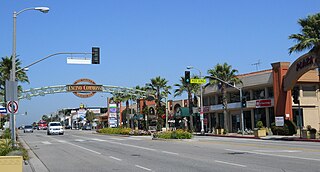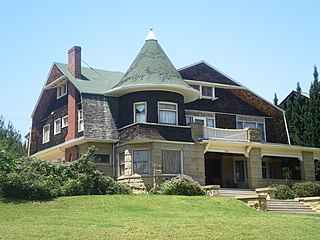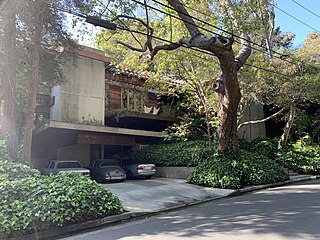
Encino is a neighborhood in the San Fernando Valley region of Los Angeles, California.

Quercus agrifolia, the California live oak, or coast live oak, is an evergreen live oak native to the California Floristic Province. Live oaks are so-called because they keep living leaves on the tree all year, adding young leaves and shedding dead leaves simultaneously rather than dropping dead leaves en masse in the autumn like a true deciduous tree. Coast live oaks may be shrubby, depending on age and growing location, but is generally a medium-sized tree. It grows west of the Sierra Nevada mountain range from Mendocino County, California, south to northern Baja California in Mexico. It is classified in the red oak section of oaks.

La Iglesia de Nuestra Señora la Reina de los Ángeles is a historic Catholic church in Los Angeles, California, located on the historic Plaza de Los Ángeles near Downtown Los Angeles. Part of the larger El Pueblo de los Ángeles Historical Monument, the church's origins date to 1784, when the Spanish founded the Nuestra Señora Reina de los Ángeles Asistencia to support nearby Mission San Gabriel Arcángel. By 1814, the asistencia had been abandoned and a new church was founded in its place by Padre Luis Gil y Taboada. The church is one of the oldest buildings in Los Angeles.

Rancho Los Encinos was a Spanish grazing concession, and later Mexican land granted cattle and sheep rancho and travelers way-station on the El Camino Real in the San Fernando Valley, in present-day Encino, Los Angeles County, California. The original 19th-century adobe and limestone structures and natural Encino Springs are now within the Los Encinos State Historic Park.

Alvarado Terrace Historic District is a designated historic district in the Pico-Union district of Los Angeles, California. It is located southwest of Downtown Los Angeles, along Alvarado Terrace between Pico Boulevard and Alvarado Street.

Los Angeles Historic-Cultural Monuments are sites which have been designated by the Los Angeles, California, Cultural Heritage Commission as worthy of preservation based on architectural, historic and cultural criteria.

The Orcutt Ranch Horticulture Center, formally known as Rancho Sombra del Roble, is a Los Angeles Historic-Cultural Monument located in the West Hills section of Los Angeles, California, USA.

Forthmann House, now known as USC Community House, is a Los Angeles Historic-Cultural Monument located in the North University Park Historic District of West Adams, Los Angeles, California. It is a 4,200-square-foot (390 m2) Victorian house built c.1887, designed by Burgess J. Reeve. It was relocated in 1989 from its original location. A secondary structure known as the Forthmann Carriage House was moved from its original location to its new home in Angelino Heights at 812 E Edgeware Rd.

The Kappe Residence is a house in the Pacific Palisades section of Los Angeles, California, designed by architect Raymond Kappe, FAIA, as his own residence. It is a modern design built into a heavily treed hillside. It was designated a Los Angeles Historic-Cultural Monument in 1996, and in 2008 it was named one of the top ten houses in Los Angeles by an expert panel selected by the Los Angeles Times.
The Forthmann Carriage House, is a Los Angeles Historic-Cultural Monument located in Angelino Heights, Los Angeles, California. It is a 1,000 sq. ft. Victorian style carriage house built c.1882, designed by Burgess J. Reeve. It was relocated in March 2006 from its original location at 629 West 18th Street. Los Angeles, California to its current location at 812 E Edgeware Rd. Los Angeles, California. The relocation was made possible thanks to the efforts of Barbara Behm, an independent developer who restored many properties in Angeleno Heights.

Chatsworth Calera also called Chatsworth Reservoir Kiln Site is one of the few surviving structures of the early 1800s lime industry. This kiln marked the introduction to California of the European industrial process for vitrifying limestone building blocks which were used in the construction of the San Fernando mission and other mission buildings. The word "Calera" is Spanish for "limestone quarry" or "limekiln". Chatsworth Calera is now located in Chatsworth, Los Angeles, California. in the Chatsworth Nature Preserve. At its peak there may have been up to five kilns at the site run by native Indian laborers. Chatsworth Calera registered a California Historical Landmark No. 911.











